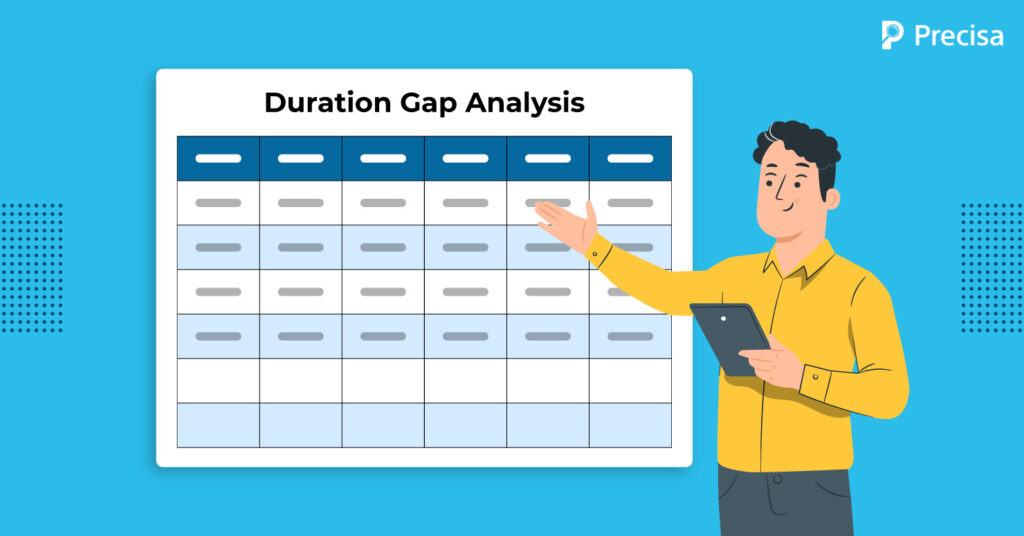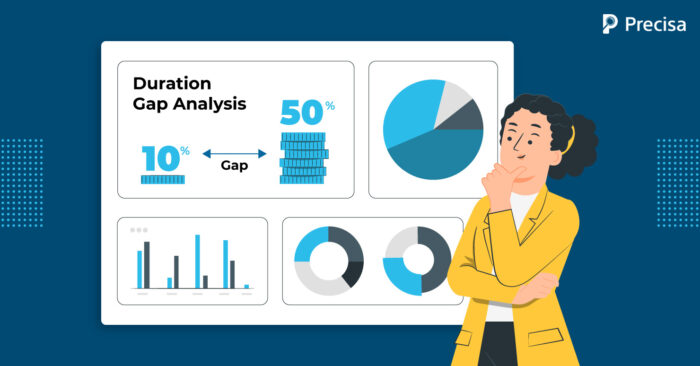All You Need to Know About Duration Gap Analysis

In the banking industry, interest rate risk is an integral part of the business. As interest rates rise, the portfolio’s value will decrease, and when interest rates fall, the portfolio’s value will increase.
The duration gap analysis measures how sensitive a portfolio’s value is to interest rate changes.
A duration gap is a financial and accounting term commonly used by banks, pension funds, and other financial institutions to identify their level of risk because of interest rate changes. This is one of the mismatches that can occur and is often referred to as an asset-liability mismatch.
In this article, we will learn how vital it is for financial stakeholders to analyse and assess the duration gap in their financial investments.
What Is a Duration Gap Analysis?
Duration Gap Analysis is an important tool for digital lenders to use when assessing the risk of their borrowers. It helps lenders determine how long a borrower will take to repay a loan.
By analysing the duration gap between the loan origination date and the date of repayment, digital lenders can better evaluate their borrowers’ risk and determine whether they are a good fit.
Leveraging Duration Gap Analysis
Duration gap analysis can be used to identify potential red flags in a borrower’s payment history.
For example, if a borrower has had a long duration gap between loan origination and repayment, this could indicate that the borrower is struggling to repay the loan.
This could make the lender think the borrowers are at a higher risk of default.
Additionally, lenders can also use duration gap analysis to identify patterns in repayment behaviour. This can help lenders better understand their borrowers and make more informed lending decisions.
Why is Duration Gap Analysis Important?
Besides identifying potential high-risk defaults, lenders can also use it in a variety of ways, such as:
- Duration Gap Analysis can be used to compare the planned duration of a project to the actual duration of a project.
- It helps to identify any potential delays in a project and allows project managers to take corrective action.
- It can also recognise areas where improvements can be made to the project management process.
- This can help to reduce costs and improve the efficiency of project completion.
- It allows managers to evaluate the impact of any changes made to the project and identify areas where further improvements can be made.
- It is also useful in helping to identify potential risks and to develop contingency plans in case of any unforeseen delays.
What Are the Advantages of Duration Gap Analysis?
The advantages of duration gap analysis include the ability to quickly identify potential risks associated with a borrower and predict future repayment behaviour.
By analysing the duration gap between origination and repayment, lenders can quickly identify borrowers at a higher risk of defaulting on their loans. Lenders can also use this information to predict when borrowers can repay their loans.
The significant benefits of duration gap analysis are as follows:
1. Improved Risk Assessment
Duration gap analysis helps lenders assess the risk of default in their loan portfolios by evaluating the duration of debts. By using this information, lenders can identify loans with a higher risk of default and adjust their loan pricing and portfolio management accordingly.
2. Increased Profitability
By using duration gap analysis, lenders can identify loans with a higher risk of default and adjust their loan pricing and portfolio management accordingly. This can help lenders increase profitability by reducing the number of default loans and charging higher interest rates on higher-risk loans.
3. Better Decision-Making
With duration gap analysis, lenders can make more informed hence better decisions about loan pricing and portfolio management. This can help lenders better manage their loan portfolios and make decisions based on data rather than intuition.
4. Reduced Operational Costs
By using duration gap analysis, lenders can reduce their operational costs. This is because lenders can identify loans with a higher risk of default and make decisions about loan pricing and portfolio management that reduce the number of loans that default. This can result in lower operational costs for lenders.
Summing It Up
Overall, duration gap analysis is a valuable tool for digital lenders. By analysing the duration gap between loan origination and repayment, lenders can quickly identify potential risks associated with a borrower and predict future repayment behaviour. This can help digital lenders make informed lending decisions and reduce risk exposure.
Additionally, duration gap analysis can be used to assess the potential impact of changes in interest rates on a portfolio. By leveraging fintech tools, investors can quickly estimate the duration risk of their portfolios and make more informed investment decisions.
Today, lenders are using innovative fintech tools to analyse the duration gap between two investments or financial transactions to determine if there is a risk. These tools can automate the calculation of the duration differences between the two investments, allowing investors to compare their durations and make better-informed decisions easily.
Precisa: Measure and Manage Risks In Your Loan Portfolios
Precisa is a cloud-based digital platform that enables financial institutions to measure and manage the risk associated with their loan portfolios.
Our user-friendly Bank Statement Analysis tool simplifies the analysis process by providing actionable insights on an easy-to-use dashboard, reducing processing time by 5x. It enables error-free analysis without human intervention. The analysis helps banks and financial institutions make sound lending decisions.
Precisa’s analytics capability can seamlessly integrate into your existing system in just a few steps, giving your team a smooth, fast, and secure experience.
Sign up for a free demo today!



